Monthly Archives: July 2020

 My grand niece, Zoey Iverson is a bubbly, smiley girl who loves life. She loves her family, and especially her older brother, Lucas. During the school closing due to Covid-19, Zoey and her brother have been spending a lot of time together, but that’s ok, because they really are best friends…more so than most siblings, I think. I’m sure that it’s because Zoey has always made sure that her brother is included in things, even if it’s just brother and sister things, like learning to walk and play. Lucas has Down Syndrome, and Zoey has played a big part in making sure that her is learning and excelling in all that he does. Nobody told her that she needed to do that. Zoey just knew.
My grand niece, Zoey Iverson is a bubbly, smiley girl who loves life. She loves her family, and especially her older brother, Lucas. During the school closing due to Covid-19, Zoey and her brother have been spending a lot of time together, but that’s ok, because they really are best friends…more so than most siblings, I think. I’m sure that it’s because Zoey has always made sure that her brother is included in things, even if it’s just brother and sister things, like learning to walk and play. Lucas has Down Syndrome, and Zoey has played a big part in making sure that her is learning and excelling in all that he does. Nobody told her that she needed to do that. Zoey just knew.


Zoey loves the outdoors and camping. I think she feels free when she is outside, but especially when she is out in nature…not just in the back yard. This year when the family went camping, Zoey decided to build her own private shelter. I think she is very resourceful…of course, she may have been taught to do this by her parents. Nevertheless, I think it’s a very cool thing to do. A girl always needs a little privacy now and then…right.
Zoey loves all aspects of the outdoors, but playing in the water on a hot day has got to be right up there on her list. She loves playing with the family dog, and entertaining her brother too. With the parents she has, I’m sure that hiking, camping, fishing, and outdoor adventures are just par for the course. Zoey is really a very grounded girl. She may only be 5 years old, but she knows what she likes, and she knows how to do many of the things common 
 to being in the wild, simply because her parents have taught her well. Zoey has been camping and fishing all her life, and she is a natural. Still, the thing that makes me smile the most, is Zoey’s love of life and everyone in it. She has a wonderful personality and attitude about everything…and she has a wonderful smile. All the best qualities in anyone. Today is Zoey’s 5th birthday!! How can she be 5 years old already. It just doesn’t seem possible, but here we are. Happy birthday Zoey!! Have a great day!! We love you!!
to being in the wild, simply because her parents have taught her well. Zoey has been camping and fishing all her life, and she is a natural. Still, the thing that makes me smile the most, is Zoey’s love of life and everyone in it. She has a wonderful personality and attitude about everything…and she has a wonderful smile. All the best qualities in anyone. Today is Zoey’s 5th birthday!! How can she be 5 years old already. It just doesn’t seem possible, but here we are. Happy birthday Zoey!! Have a great day!! We love you!!
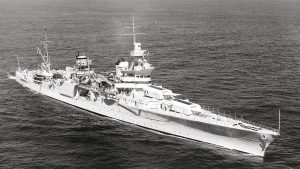 The USS Indianapolis (CL/CA-35) was a Portland-class heavy cruiser of the United States Navy, named for the city of Indianapolis, Indiana. The ship was launched in 1931, the vessel served as the flagship for the commander of Scouting Force 1 for eight years, then as flagship for Admiral Raymond Spruance in 1943 and 1944 while he commanded the Fifth Fleet in battles across the Central Pacific during World War II. Those were tumultuous times, and sometimes things “fell through the cracks,” but what happened to the USS Indianapolis was seriously unthinkable.
The USS Indianapolis (CL/CA-35) was a Portland-class heavy cruiser of the United States Navy, named for the city of Indianapolis, Indiana. The ship was launched in 1931, the vessel served as the flagship for the commander of Scouting Force 1 for eight years, then as flagship for Admiral Raymond Spruance in 1943 and 1944 while he commanded the Fifth Fleet in battles across the Central Pacific during World War II. Those were tumultuous times, and sometimes things “fell through the cracks,” but what happened to the USS Indianapolis was seriously unthinkable.
In July 1945, after the Indianapolis completed a top-secret high-speed trip to deliver parts of Little Boy, the first nuclear weapon ever used in combat, to the United States Army Air Force Base on the island of Tinian, they subsequently departed for Guam and then it was on to the Philippines on training duty. Little Boy was the bomb that was going to effectively end the war, but the war was not over yet, and it was imperative that everyone be on high alert. The waters in many areas of the world were filled with hidden dangers…namely, German U-Boats and Imperial Japanese Navy Submarines. Many a ship was sunk by these hidden enemies.
At 12:05am on July 30, 1945, the USS Indianapolis was torpedoed by the Imperial Japanese Navy submarine I-58, while en route to the Philippines. The mighty ship sank in just 12 minutes. There were 1,195 crewmen aboard, and approximately 300 went down with the ship, unable to get to the deck in time. The remaining 890 men were faced with exposure, dehydration, saltwater poisoning, and shark attacks while stranded in the open ocean with few lifeboats and almost no food or water. The scene was horrible. The men in the water could not necessarily see the sharks, but the screams of their fellow crewmen were unmistakable. And if the crew wasn’t dying by shark attack, they were slowly dying at the hands of the elements. Dehydration caused many to drink the saltwater that was in abundance around them, but soon it poisoned them, and instead of saving them, it killed them.
Because of the speed with which USS Indianapolis sank, there was no time to send a distress signal or even  deploy all of the lifeboats and equipment. The men knew they would need to survive until their ship was overdue and reported missing. They didn’t know how long it would take, and this is where the Navy failed these men. Navy directive 10CL45, which meant no reporting of combatant ships that failed to arrive. No search until by accident someone saw an oil slick. When Indianapolis was overdue, the people who would have reported it as overdue, simply assumed that Indianapolis might have been redeployed to another training area, since that was part of their mission. According to the directive, no search crews were sent out. These men were unthinkably alone in the vast sea…and no help was coming. In fact, the Navy only learned of the sinking four days later, when survivors were spotted by the crew of a PV-1 Ventura on routine patrol. By the time the rescue began, only 316 of the 890 men who survived the original sinking were still alive. The sinking of Indianapolis and Navy directive 10CL45 resulted in the greatest single loss of life at sea from a single ship in the history of the US Navy.
deploy all of the lifeboats and equipment. The men knew they would need to survive until their ship was overdue and reported missing. They didn’t know how long it would take, and this is where the Navy failed these men. Navy directive 10CL45, which meant no reporting of combatant ships that failed to arrive. No search until by accident someone saw an oil slick. When Indianapolis was overdue, the people who would have reported it as overdue, simply assumed that Indianapolis might have been redeployed to another training area, since that was part of their mission. According to the directive, no search crews were sent out. These men were unthinkably alone in the vast sea…and no help was coming. In fact, the Navy only learned of the sinking four days later, when survivors were spotted by the crew of a PV-1 Ventura on routine patrol. By the time the rescue began, only 316 of the 890 men who survived the original sinking were still alive. The sinking of Indianapolis and Navy directive 10CL45 resulted in the greatest single loss of life at sea from a single ship in the history of the US Navy.

 In a day and age when more and more young people are so intent on “fitting in” that they lose sight of who they really are, my grand niece, Raelynn Masterson is, refreshingly, not a follower. Raelynn remains true to herself, and she is just fine with who she is. Her mom tells me that she is a lot like both her parents, and while that may be true, I don’t think it is genetics, as much as it is good upbringing. Raelynn figures that if you like her…great, but if not…it’s your problem, not hers. I think that is the best way to be.
In a day and age when more and more young people are so intent on “fitting in” that they lose sight of who they really are, my grand niece, Raelynn Masterson is, refreshingly, not a follower. Raelynn remains true to herself, and she is just fine with who she is. Her mom tells me that she is a lot like both her parents, and while that may be true, I don’t think it is genetics, as much as it is good upbringing. Raelynn figures that if you like her…great, but if not…it’s your problem, not hers. I think that is the best way to be.
Raelynn is a has such a sweet attitude. She is a good big sister, and is always kind to her siblings. She is helpful when they need it, and that is especially nice when their parents are at work, and her siblings need some advise and encouragement. Their parents know that they are in good hands when Raelynn is there with them. There is, of course, a difference between a sweet attitude, and a pushover, and Raelynn is no push over. Once her mind is made up, it is and she won’t be moved. If you try to cross her, and you make the mistake of making this girl mad…well, as her mom says, “I’ll pray for you.” Personally, I have not seen that side of Raelynn, but then we are not really on opposite sides of things, and maybe I think I’m glad we aren’t too.
As with most people, the things going on in our world have caused Raelynn to look more closely into politics. Her parents have encouraged their children to look into a matter, and make an informed decision about where you stand. That’s a good way to be. We have too many blind followers, as it is. Raelynn, and her siblings, Matt and Anna, as well as Christina (who is grown and living on her own), are not required to agree with their parents views on things. Their parents, Rob and Dustie, think it is important for them to make up their own minds, even when they don’t match their parents views. Raelynn’s opinions on politics don’t always match those of her parents, but she is required to look deeper into things before forming her opinions…using legitimate sites (or, as close as you can get these days). There have been a few heated debates between Raelynn and her brother, Matt, which have required a parental mediator at times. My guess is that there have been some between her and her parents too, but that really is the only way to learn about politics and I’m sure that as time goes by, her opinions will grow and change, whether they ever match those of her parents or not.
The family recently got a dog, and as often happens with pets, Azura has decided that Raelynn is “her human.” 
 They are so close, and almost inseparable when Raelynn is home. It was completely unexpected, but if Rob or Dustie are looking for one, all they need to do is find the other. Raelynn and Azura are practically joined at the hip. The hardest part about this “exceptionally close” relationship, is that whenever Raelynn is gone, Azura is totally miserable until she gets home!! That could be really bad when school starts again. Azura just loves Raelynn so much. I can see why, because we all do too. Today is Raelynn’s 17th birthday. Happy birthday Raelynn!! Have a great day!! We love you!!
They are so close, and almost inseparable when Raelynn is home. It was completely unexpected, but if Rob or Dustie are looking for one, all they need to do is find the other. Raelynn and Azura are practically joined at the hip. The hardest part about this “exceptionally close” relationship, is that whenever Raelynn is gone, Azura is totally miserable until she gets home!! That could be really bad when school starts again. Azura just loves Raelynn so much. I can see why, because we all do too. Today is Raelynn’s 17th birthday. Happy birthday Raelynn!! Have a great day!! We love you!!
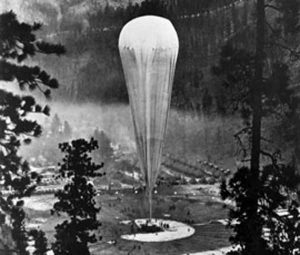
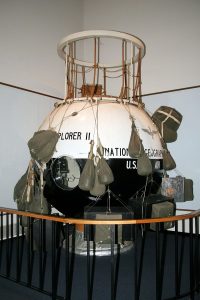 In the Black Hills of South Dakota, south-west of Rapid City lies a natural depression in the Earth. Apparently, the depression is a sinkhole that has 700 feet deep cliff walls all around, that prevent wind from reaching the bottom. The windless part of the site is what makes it perfect for balloon launches. The site was noticed by the National Geographic Society and the United States Army Air Corps, who set up what they called Stratocamp in 1934-1935. Stratocamp was a joint effort code named Explorer to launch two manned giant helium high-altitude balloons capable of stratospheric flight. The crash of the Soviet Osoaviakhim-1 after setting a world record flight of 72,178 feet (13.71 miles), the Explorer program set a new goal…to beat that record. The first Explorer balloon was launched on July 28, 1934. The balloon made it 11 miles up before it disintegrated. Thankfully the astronauts onboard had parachutes on, so they survived.
In the Black Hills of South Dakota, south-west of Rapid City lies a natural depression in the Earth. Apparently, the depression is a sinkhole that has 700 feet deep cliff walls all around, that prevent wind from reaching the bottom. The windless part of the site is what makes it perfect for balloon launches. The site was noticed by the National Geographic Society and the United States Army Air Corps, who set up what they called Stratocamp in 1934-1935. Stratocamp was a joint effort code named Explorer to launch two manned giant helium high-altitude balloons capable of stratospheric flight. The crash of the Soviet Osoaviakhim-1 after setting a world record flight of 72,178 feet (13.71 miles), the Explorer program set a new goal…to beat that record. The first Explorer balloon was launched on July 28, 1934. The balloon made it 11 miles up before it disintegrated. Thankfully the astronauts onboard had parachutes on, so they survived.
The second balloon was launched in November 11, 1935, and ascended 14 miles up, before landing near White Lake, South Dakota. They had done it. That second flight set a world record that would not be broken until astronauts started flying into space. Astronauts, Air Corps Captain Albert William Stevens, Captain Arson Anderson, and Major William E. Kepner became the first men to view the Earth’s curvature. This exploration helped the Air Force build better planes and helped scientists build satellites.
In the 1950s, Project Manhigh and Project Strato-Lab launches were made from a man-made crater of an iron mining pit near Crosby, Minnesota, and if weather allowed, from Fleming Field in South Saint Paul, Minnesota. The Stratobowl was used as a backup location, if launches could not be made at the Minnesota locations. As it turned out, the Stratobowl was needed for a number of launches. The first such launch was on November 8, 1956, when the Strato-Lab I gondola lifted Malcolm Ross and M L Lewis from the Stratobowl to a world altitude record for manned balloon flight of 76,000 feet. There were also three Stratobowl launches in 1958, and seven in 1959. The most publicized flight was that of Strato-Lab IV, piloted by Malcolm Ross and Charles B Moore, which lifted off from Stratobowl on November 28, 1959. The balloon reached an altitude of 81,000 feet, and landed safely in Kansas after 20 hours in the air. The purpose of the flight was to perform spectrographic analysis of the planet Venus with minimal interference from the Earth’s atmosphere.
These days, the Stratobowl is usually seen from a popular hiking trail that takes you up to the rim…which is 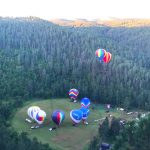
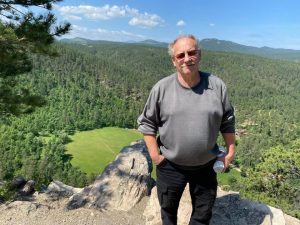 how my husband, Bob and I first saw it. You can also drive down to the bottom, and there are festivals during which balloons are launched…to go to normal heights and to take tourists and owners for a normal ride. No records are set to be won, or experiments to be made. Still, looking at the Stratobowl from the top of the trail is very impressive, and while it is not a difficult or a long hike, we enjoyed it very much, and it is a short hike that I very much recommend. It was really interesting, and to think it is a sinkhole.
how my husband, Bob and I first saw it. You can also drive down to the bottom, and there are festivals during which balloons are launched…to go to normal heights and to take tourists and owners for a normal ride. No records are set to be won, or experiments to be made. Still, looking at the Stratobowl from the top of the trail is very impressive, and while it is not a difficult or a long hike, we enjoyed it very much, and it is a short hike that I very much recommend. It was really interesting, and to think it is a sinkhole.
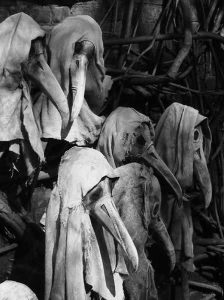
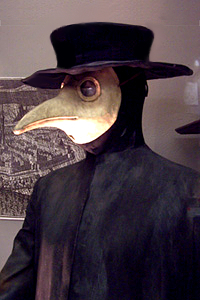 Imagine, waking up from a feverish delirium, to find yourself staring into the face of a doctor who looked like some type of bird, and a scary one at that. When people are delirious and feverish, they are already not in their right mind, so looking at the man, who looked like a giant hawk, could be…well, frightening. The poor sick patient, might have believed that they had been abducted by aliens.
Imagine, waking up from a feverish delirium, to find yourself staring into the face of a doctor who looked like some type of bird, and a scary one at that. When people are delirious and feverish, they are already not in their right mind, so looking at the man, who looked like a giant hawk, could be…well, frightening. The poor sick patient, might have believed that they had been abducted by aliens.
Medicine has come a long way over the centuries. Long ago, physicians in Europe thought that diseases were caused by “bad air.” Scientists like Louis Pasteur, Robert Koch, and Joseph Lister hadn’t yet come up with the scientific proof of the germ theory of disease. Sometimes, it just makes you wonder how anyone managed to survive in those days. Still, the doctors did know that somehow they needed to protect themselves, be it from the “bad air” or germs that they didn’t even know existed. I guess they figured that “when in doubt…protect yourself” first. It was good advise then and good advise now. A healthcare worker, be it doctor, nurse, cna, or caregiver, cannot be of any use to their patient, if they get sick too.
So, to safeguard themselves against miasma, which was the name they gave to this “bad air” and since the doctors then didn’t know about the kinds of gear that is available these days, the doctors donned a curious accessory while treating sickly patients…a mask with a long, bird-like beak, which was stuffed with dried flowers, herbs, and spices. The gear was used during the Carnival of Venice, so some people might recognize it as the “plague doctor” costumes, but they probably wouldn’t know that, with the costumes were an exaggeration, this type of gear was really used during plagues in the 17th century.
It is thought that doctors accepted this type of mask, thanks in part to the Black Death, which ravaged the Middle East, Asia, and Europe during the 14th century, but medical historians say it wasn’t invented until three 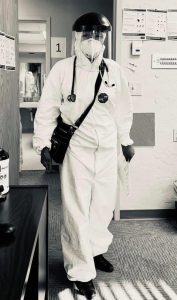 centuries later, when a 16th century French doctor named Charles de Lorme likely designed what could be described as one of history’s earliest hazmat suits during later waves of the plague, and it was very similar to these. I’m sure they did the best they could, but my guess is that is was sorely inadequate. The de Lorme suit consisted of “a full head-to-toe protective garment, modeled after a soldier’s canvas gown which went from the neck to the ankle. The over-clothing garment, as well as leggings, gloves, boots, and a hat, were made of waxed leather. The garment was impregnated with similar fragrant items as the beak mask.”
centuries later, when a 16th century French doctor named Charles de Lorme likely designed what could be described as one of history’s earliest hazmat suits during later waves of the plague, and it was very similar to these. I’m sure they did the best they could, but my guess is that is was sorely inadequate. The de Lorme suit consisted of “a full head-to-toe protective garment, modeled after a soldier’s canvas gown which went from the neck to the ankle. The over-clothing garment, as well as leggings, gloves, boots, and a hat, were made of waxed leather. The garment was impregnated with similar fragrant items as the beak mask.”
These days, our healthcare workers, who are working with serious diseases, such as Covid-19, wear gear that is much more capable of protecting them. Healthcare workers like my friend, Nurse Practitioner, Angela Booth might look like they are wearing…well, almost bunkers, like a firefighter wears, with the exception of the heavy oxygen, of course. Still, the gear they are wearing is highly sophisticated and is much better able to protect them from the disease, than gear used to be, and anyone who has friends or family in the healthcare industry, can be thankful for that. For patients, it might still be scary to see the doctor or nurse dressed that way.
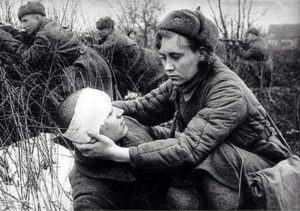 When Natalia Peshkova was a girl in high school, during the early years of World War II, women were not allowed to join the Russian Army. Nevertheless, the women of Russia wanted to help, just like women from most of the Allied nations. As the war went on, the need for soldiers brought women into the draft…like it or not. Peshkova found herself recruited right out of high school, and at the age of 17, she was set to be a combat medic.
When Natalia Peshkova was a girl in high school, during the early years of World War II, women were not allowed to join the Russian Army. Nevertheless, the women of Russia wanted to help, just like women from most of the Allied nations. As the war went on, the need for soldiers brought women into the draft…like it or not. Peshkova found herself recruited right out of high school, and at the age of 17, she was set to be a combat medic.
Things were tough in the arena Peshkova found herself in. The poorly equipped unit was faced with weapons that continuously malfunctioned…not a good thing to defend yourself with. Peshkova’s stint in the Russian army was filled with constant disease, starvation, and even the loss of a boot to a hungry horse, while she slept. To say the least, life in the Russian army was tough.
Despite the hardships, Peshkova did her duty as a combat medic, protecting and helping soldiers that were wounded on the front lines as much as she could. Her training taught her to protect wounded soldiers from the front and get them safely to hospitals, often placing herself in possible harm’s way. While she was trained to apply first aid, her main duty was always to remove wounded men from the front line. Trying to do first aid on the front lines was a dangerous maneuver for both soldier and medic. Peshkova was wounded three times for her efforts, but she had a kind of strength and determination that was unmatched in the field, and she always returned to the front when she had healed. I’m sure many people thought she was half crazy.
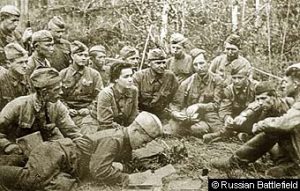
At one point, Peshkova got separated from her unit, finding herself behind enemy lines when the Germans took over territory previously held by the Russians. She had to act fast, so she disguised herself, while also hiding her weapon, because if she discarded it, she would have been executed by her own military. She finally made it back to her unit and survived three years on the front lines. She rose through the ranks to become Sergeant Major, and was then given political education duties that finally relived her from life on the front lines. Natalia Peshkova was truly one of a kind, and was awarded the Order of the Red Star for Bravery.
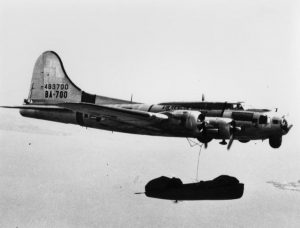 Built in Seattle, Washington by Boeing, the B-17G, which was later converted to a B-17H for use as an emergency air-sea rescue plane. It was equipped with a Higgins A-1 lifeboat attached to the lower fuselage. The plane and crew including Pilot, 1st Lieutenant William C Motsinger; Co-Pilot, 2nd Lieutenant Robert W Ball; Crew, 1st Lieutenant Rollin C Marsh; Engineer, Captain Norman E Zahrt; Navigator, Technical Sergeant Robert W Conger; Gunner, Staff Sergeant Gerard J Doody; Crew, Staff Sergeant Charles J Parkins; Crew, Sergeant Charles Edward Hurn; Crew, Sergeant Elliott Leroy Griffin; and Crew, Sergeant Otis E Anderson Jr; was assigned to the 20th Air Force, 4th Emergency Rescue Squadron. The plane was given no known name or nose art, which happened more than people knew, but it had a Radio Call Sign of “Jukebox 21.”
Built in Seattle, Washington by Boeing, the B-17G, which was later converted to a B-17H for use as an emergency air-sea rescue plane. It was equipped with a Higgins A-1 lifeboat attached to the lower fuselage. The plane and crew including Pilot, 1st Lieutenant William C Motsinger; Co-Pilot, 2nd Lieutenant Robert W Ball; Crew, 1st Lieutenant Rollin C Marsh; Engineer, Captain Norman E Zahrt; Navigator, Technical Sergeant Robert W Conger; Gunner, Staff Sergeant Gerard J Doody; Crew, Staff Sergeant Charles J Parkins; Crew, Sergeant Charles Edward Hurn; Crew, Sergeant Elliott Leroy Griffin; and Crew, Sergeant Otis E Anderson Jr; was assigned to the 20th Air Force, 4th Emergency Rescue Squadron. The plane was given no known name or nose art, which happened more than people knew, but it had a Radio Call Sign of “Jukebox 21.”
B-17H Flying Fortress Serial Number 43-38882, aka Jukebox 21, took off from Motoyama Number 1 Airfield on Iwo Jima, on July 25, 1945, on a night search mission for F4U Corsair 81319 that crashed the day before near Arai at roughly over Lat 34° 35′ N, Long 137° 35′ E on the southern coast of Honshu, Japan. The weather was good, and yet Jukebox 21 was lost, without making a distress signal. That fact made the circumstances of the crash hard to figure, and only known when the B-17 failed to return. The crew was officially listed as Missing In Action, and later as killed in action.
The B-17 flew over Maisaka near the Benten Jima bridge, flying northward at an altitude of roughly 984 feet. Crossing the coast, 75mm anti-aircraft guns on the south side of the highway at Benten Jima opened fire on the bomber. Jukebox 21 was hit by anti-aircraft fire, one of the engines began smoking as the plane flew northward, then attempted to circle to the west over Lake Hamana, then southward. Trailing black smoke, one of the engines on the right wing broke off before the bomber crashed at Yakute to the northwest of Arai. Jukebox 21 impacted pine trees before crashing into the ground nose first at Yakute, to the northwest of Arai. Immediately after the crash, Japanese civilians ran to the crash site and observed several mounds of debris and fire and observed the rescue boat in the wreckage. There were no survivors. Thirty minutes after the crash, Japanese Keibodan (wartime guards) reached the crash site and extinguished the fire. The bodies of the ten crew were recovered, all badly burned from the fire and no identification was possible. Afterwards, the bodies of the crew were cremated and buried at the nearby Arai crematorium, along with the body of the Corsair pilot that crashed the previous day.

Twelve Allied aircraft participated in a search over two days under the direction of Major Ivan K Mays. No wreckage was located, and all stations and ships were told to be on the lookout for this bomber. On May 22, 1947 US Army investigators visited Arai to investigate the possibilities of any atrocities in connection with the death of this crew, but found none. During their visit, they interrogated Katsumi Kumagai the former Kempei Tai commander for Arai who explained how the B-17 crashed and how the crew’s bodies were recovered, cremated, and buried. Afterwards, the remains of the crew were recovered and transported to the United States for permanent burial. Somewhat strangely, the Japanese placed a memorial to the men of Jukebox 21 at the Jingu-ji Temple in Kosai, Japan.
 Every child, at some point in their academic career, is required to do a science fair project. Some are good, because let’s face it, some students are very good at science…or some kids have parents who can do the project for them. I watched a show recently in which a couple of students were making volcanos for the science fair. I started thinking about some of the science fair projects I did during my own academic career. I really don’t recall ever making a volcano, and I knew that you used baking soda, but that was about all I knew. I suppose it’s possible that one of my teachers made one in our science class, but maybe not too.
Every child, at some point in their academic career, is required to do a science fair project. Some are good, because let’s face it, some students are very good at science…or some kids have parents who can do the project for them. I watched a show recently in which a couple of students were making volcanos for the science fair. I started thinking about some of the science fair projects I did during my own academic career. I really don’t recall ever making a volcano, and I knew that you used baking soda, but that was about all I knew. I suppose it’s possible that one of my teachers made one in our science class, but maybe not too.
I remember several of my own science projects. I think most of us build our solar system…again, some much better than others. If science wasn’t your forte, it just wasn’t. I didn’t mind science, but it wasn’t really the thing I wanted to do with my life either. I just wasn’t inclined to apply myself to the different aspects of science. Nevertheless, I did like the solar system, even now. I find the constellations very interesting. At one time, I could pick them out.
One time, I decided, or rather it was suggested to me, by the neighbor across the alley to build a radio. He was  trained in electronics, and we had a great time building that radio. I think Mom and Dad had just as much fun as we did, because they watched with great interest as we soldered transistors and other components together to make a radio that worked, even if it wasn’t small and cool like a transistor radio, but rather like a jewelry sized army green box. Nevertheless, it worked, and while I didn’t win the science fair, I learned a lot about how a radio worked, and after all, isn’t that the whole purpose.
trained in electronics, and we had a great time building that radio. I think Mom and Dad had just as much fun as we did, because they watched with great interest as we soldered transistors and other components together to make a radio that worked, even if it wasn’t small and cool like a transistor radio, but rather like a jewelry sized army green box. Nevertheless, it worked, and while I didn’t win the science fair, I learned a lot about how a radio worked, and after all, isn’t that the whole purpose.
One of my projects, however, will always be remembered as the the grossest/funniest (now, not then) project I ever did. My poor mom!! I decided to do a project on honey. It seems benign enough, and I did know that honey came from bees. I guess I thought I was going to cut out pictures of bees, but Mom had other ideas. Somehow she managed to talked to a beekeeper, who willingly supplied us with honeycomb, which I thought was very cool. We put it in a baggy so it wouldn’t leak everywhere, and put it on the board we were putting my project 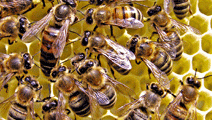 on. That was great, however…the beekeeper also supplied him with 50 or so dead bees to put on the board. They were in a box, and we had to put them in a baggy…or rather my mom had to put them in a baggy. I don’t like bugs…of any kind, and I refused to touch them. In retrospect, I suppose we could have used a spoon or something, but Mom bravely began to pick them up and put them into a baggy…until they started clinging to her. Then, she was just as grossed out as I was. Somehow, I don’t recall how we finally got those wretched, dead bees into their baggy, but somehow we did, and the project was completed. I learned a lot about the making of honey too, and that I never wanted to touch a bee…dead or alive…EVER!!!
on. That was great, however…the beekeeper also supplied him with 50 or so dead bees to put on the board. They were in a box, and we had to put them in a baggy…or rather my mom had to put them in a baggy. I don’t like bugs…of any kind, and I refused to touch them. In retrospect, I suppose we could have used a spoon or something, but Mom bravely began to pick them up and put them into a baggy…until they started clinging to her. Then, she was just as grossed out as I was. Somehow, I don’t recall how we finally got those wretched, dead bees into their baggy, but somehow we did, and the project was completed. I learned a lot about the making of honey too, and that I never wanted to touch a bee…dead or alive…EVER!!!
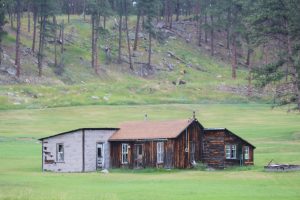 When we think of “ghost towns,” we think of abandoned mining camps, towns that were passed by when railroads or highways went through, and these days, New York City. There are many ways for a town or even a city to die out…most of them are really sad. Sometimes, a town just outlives its usefulness, as was the case during the gold rush. When the gold ran out, the miners moved on or went back east to their homes there. The little town that had provided the supplies, homes, entertainment, and necessary offices, like post office and land offices, is simply not needed anymore. I’m sure that the people of the town held out as long as it made sense, and then they picked up and moved on to some other place that needed things like a general store for supplies. The little town then sat there and slowly slipped into disrepair and decay. When we visit such towns, we see history unfolding before us, and we are usually excited to find such an amazing relic. We can’t wait to explore.
When we think of “ghost towns,” we think of abandoned mining camps, towns that were passed by when railroads or highways went through, and these days, New York City. There are many ways for a town or even a city to die out…most of them are really sad. Sometimes, a town just outlives its usefulness, as was the case during the gold rush. When the gold ran out, the miners moved on or went back east to their homes there. The little town that had provided the supplies, homes, entertainment, and necessary offices, like post office and land offices, is simply not needed anymore. I’m sure that the people of the town held out as long as it made sense, and then they picked up and moved on to some other place that needed things like a general store for supplies. The little town then sat there and slowly slipped into disrepair and decay. When we visit such towns, we see history unfolding before us, and we are usually excited to find such an amazing relic. We can’t wait to explore.
Sometimes, as in the case of New York City, a city is “shut down” to help those within it to recover from something, such as a pandemic. That doesn’t usually happen when a new virus goes through, but it did with  Covid-19. Normally, only the sick people are quarantined, but in this case, the medical experts (and many people would say that I’m using that term loosely), decided to quarantine the well people in the hope of stopping the spread of Covid-19. I can’t say whether that has been a good or a bad thing, but I tend to think it was a bad thing. When a city like New York City, suddenly is completely empty, businesses are shut down, jobs lost, and it didn’t seem to help. Months later, the city is still, for the most part, shut down, and businesses are considering a move to another location, just like the ghost towns of the old west when the mines dried up. The shut down of our cities is a slippery slope, and one that I think needs to be avoided, at all costs. Still, man will tell you that I’m not an expert, and they would be right. I am just a person who sees that our country cannot continue with this shut down much longer. Something has to change…something!!
Covid-19. Normally, only the sick people are quarantined, but in this case, the medical experts (and many people would say that I’m using that term loosely), decided to quarantine the well people in the hope of stopping the spread of Covid-19. I can’t say whether that has been a good or a bad thing, but I tend to think it was a bad thing. When a city like New York City, suddenly is completely empty, businesses are shut down, jobs lost, and it didn’t seem to help. Months later, the city is still, for the most part, shut down, and businesses are considering a move to another location, just like the ghost towns of the old west when the mines dried up. The shut down of our cities is a slippery slope, and one that I think needs to be avoided, at all costs. Still, man will tell you that I’m not an expert, and they would be right. I am just a person who sees that our country cannot continue with this shut down much longer. Something has to change…something!!
While we like to visit ghost towns, we often don’t realize the hardship and heartache that went into turning these places into ghost towns. Just like we have seen in the cities across America, the business shutting down 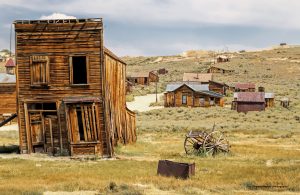 means the loss of a livelihood for millions of people. Depression sets in, and eventually everyone is angry about their rights being stepped on…and it’s not just one group, it’s many. Then, the sad thing is that there emerges a group of people who are…left out. The ones who don’t fit into any of the protesting groups…they are the quiet majority…the ones who usually just go quietly about their daily lives, without hurting anyone. Sadly these are the overlooked ones, and usually the last ones to leave the ghost town, because they are the ones who try to hope for the future. These days, that is much of America. We are just hanging out, waiting for things to get better, so we can get back to normal. Here’s to normal.
means the loss of a livelihood for millions of people. Depression sets in, and eventually everyone is angry about their rights being stepped on…and it’s not just one group, it’s many. Then, the sad thing is that there emerges a group of people who are…left out. The ones who don’t fit into any of the protesting groups…they are the quiet majority…the ones who usually just go quietly about their daily lives, without hurting anyone. Sadly these are the overlooked ones, and usually the last ones to leave the ghost town, because they are the ones who try to hope for the future. These days, that is much of America. We are just hanging out, waiting for things to get better, so we can get back to normal. Here’s to normal.
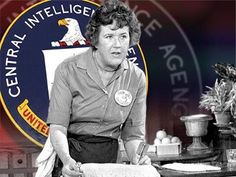 Most of us know Julia Child as a famous chef, who mainly focused on French cuisine, as well as an author of cookbooks, but that is only one aspect of her life. Born Julia Carolyn McWilliams in Pasadena, California on August 15, 1912, she was the daughter of John McWilliams Jr, and Julia Carolyn “Caro” (Weston) McWilliams. She came from wealth as privilege, her dad being a Princeton Graduate and prominent land manager, and her mom being a paper-company heiress. She was the eldest of three children, followed by John McWilliams III and Dorothy (McWilliams) Cousins. Child and her siblings were all unusually tall, and loved outdoor sports. After she graduated, Julia went on to major in history in college, after college took a job as a copywriter for a furniture company in New York City.
Most of us know Julia Child as a famous chef, who mainly focused on French cuisine, as well as an author of cookbooks, but that is only one aspect of her life. Born Julia Carolyn McWilliams in Pasadena, California on August 15, 1912, she was the daughter of John McWilliams Jr, and Julia Carolyn “Caro” (Weston) McWilliams. She came from wealth as privilege, her dad being a Princeton Graduate and prominent land manager, and her mom being a paper-company heiress. She was the eldest of three children, followed by John McWilliams III and Dorothy (McWilliams) Cousins. Child and her siblings were all unusually tall, and loved outdoor sports. After she graduated, Julia went on to major in history in college, after college took a job as a copywriter for a furniture company in New York City.
With the onset of World War II, Julia tried to enlist in military service, but was told that she was too tall to enlist in the Women’s Army Corps (WACs) or in the U.S. Navy’s WAVES…both facts that make no sense to me, and probably would not have been a factor these days. Nevertheless, Julia was declined that chance to serve. 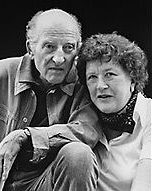 Undeterred, she joined the Office of Strategic Services (OSS) as a typist at its headquarters in Washington but, because of her education and experience, soon was given a more responsible position as a top-secret researcher working directly for the head of OSS, General William J. Donovan. Thus began a career that would lead to being a spy for the Allied forces and have a life changing effect on Julia’s life.
Undeterred, she joined the Office of Strategic Services (OSS) as a typist at its headquarters in Washington but, because of her education and experience, soon was given a more responsible position as a top-secret researcher working directly for the head of OSS, General William J. Donovan. Thus began a career that would lead to being a spy for the Allied forces and have a life changing effect on Julia’s life.
In 1944, she was posted to Kandy, Ceylon (now Sri Lanka). Her responsibilities included “registering, cataloging and channeling a great volume of highly classified communications” for the OSS’s clandestine stations in Asia. Later she was transferred to Kunming, China, where she received the Emblem of Meritorious Civilian Service as head of the Registry of the OSS Secretariat. Asked to solve the problem of too many OSS underwater explosives being set off by curious sharks, “Child’s solution was to experiment with cooking various concoctions as a shark repellent,” a task she did in a bathtub…not much like her cooking in later years. The chemicals were sprinkled in the water near the explosives and repelled sharks…it was a great success and is still in use today. The experimental shark repellent “marked Child’s first foray into the  world of cooking” Child received an award that cited her many virtues, including her “drive and inherent cheerfulness.”
world of cooking” Child received an award that cited her many virtues, including her “drive and inherent cheerfulness.”
While in Kunming, she met Paul Cushing Child, also an OSS employee, and the two were married September 1, 1946, in Lumberville, Pennsylvania. They later relocated to Washington DC. Paul was a New Jersey native who had lived in Paris as an artist and poet. He was also known for his sophisticated palate, and introduced his wife to fine cuisine. Julia had always had a cook in her childhood home, so the idea of cooking was very foreign to her. Still, she was smart, and she began to excel in the art of cooking. It was her cooking that helped her to realize another of her goals…to become an author. Cooking was not a goal is a girl, but it was her later love of cooking that finally gave her the title of writer she had so desired. While Julia and Paul never had children, they lived a long and happy life until his passing in 1994. Then she went on until her own passing in 2004 at the good old age of 91.

